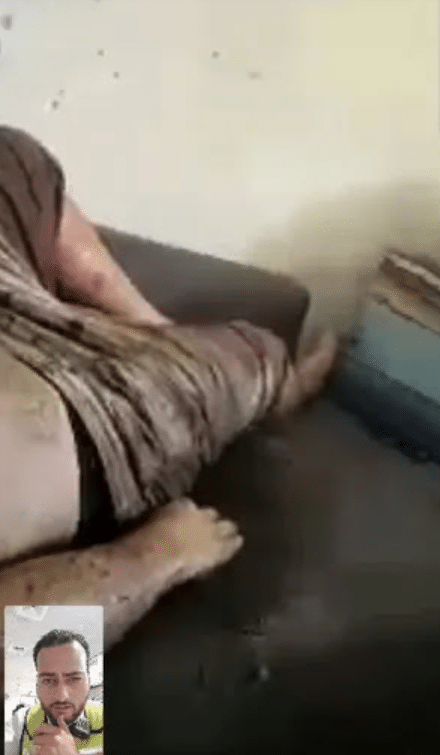The massacre at Be’eri was not a single outburst of violence, over in a terrifying instant. It was a prolonged rampage, in which dozens of terrorists roamed freely through a pastoral village, killing methodically and with cruelty.
A 10-week New York Times investigation into what happened at Be’eri, based on interviews with scores of survivors and witnesses as well as on videos, text messages and recordings of phone calls, revealed a nightmare that lasted from just after dawn until well into the next day.
For a nation founded as a safe haven for Jews, the atrocities of Be’eri stand out as a defining trauma of the Oct. 7 attacks. An estimated 1,200 people died after Hamas and its allies surged across the border that day, provoking an Israeli campaign in Gaza that has killed roughly 20,000 people.
We interviewed more than 80 survivors, victims’ relatives, village leaders, soldiers and medics, and verified more than nine hours of security camera footage as well as phone and bodycam video shot by Gazans. We also reviewed more than 1,000 text messages and voice recordings, and used three-dimensional footage of Be’eri taken by Treedis, an Israeli software company, in the days after the massacre to reconstruct several sites where people were killed.
[The New York Times Report continues]
Hamas gunmen and their allies focused their attack on the western parts of the village, the area closest to Gaza. They ransacked those neighborhoods house by house, systematically setting fire to scores of homes, killing many of those they found inside and abducting others.
In the center of the village, the gunmen slaughtered most of the people hiding inside a besieged health clinic. On the eastern flank of Be’eri, another squad of attackers gathered 14 hostages inside a ransacked home and used them as human shields during a standoff with Israeli forces; some of the hostages were killed in the crossfire, during a delayed and chaotic military response.
Residents were shot in their bedrooms, on the sidewalk, and under trees, where they lay like rag dolls in a heap. Others were trapped in burning buildings, their bodies found charred beyond recognition. The oldest victim was 88, and the youngest was less than a year old.
If there was method to the assault, there was also randomness to it. Some residents who hid in bathrooms or shrubbery survived while many who sheltered in safe rooms were killed.
Spouses lost lifelong partners. Parents lost children. Children lost parents.
Hadar Bachar, a poised 13-year-old who had planned to spend the day at a village festival, was determined to save her father after he was shot.
From the safe room, she made a video call to the ambulance service, which it recorded and later shared with the family.
[The New York Times Report continues]
6:56 a.m.: A Rampage Begins
Hamas gunmen approaching the kibbutz gate.
Note: The surveillance camera clock is set one hour behind.
Kibbutz surveillance footage, via the Israeli military
Surveillance footage shows the first Hamas militants emerging from the woods on the edge of Be’eri shortly after sunrise. There were two of them, clad in combat uniforms and carrying assault rifles. They crept cautiously toward the village entrance, one wearing a green Hamas bandanna and the other a back-to-front cap.
Many residents were already awake, jolted from sleep roughly 25 minutes earlier by an unusually intense barrage of rockets from Gaza. The rockets had been mostly intercepted by Israel’s air-defense system, and some villagers resumed their Saturday routines.
One man was out jogging. Several loaded their cars with bicycles, ready for a day in the countryside. A team of chefs had begun to prepare breakfast at the dining hall.
[The New York Times Report continues]
The kibbutz was founded on the night of Oct. 5, 1946, one of 11 Jewish outposts established at the same time in an area largely populated by Arabs. In 1948, Arabs and Jews fought over the area during a war that forged the boundaries of the new state of Israel.
Egypt captured a sliver of nearby coastal land that became known as the Gaza Strip, and Be’eri became an Israeli border town, a short drive from Gaza’s eastern edge.
Israel occupied Gaza during the 1967 Arab-Israeli war, withdrawing its troops in 2005 to allow Palestinians to run the territory. Hamas, an Islamist group opposed to Israel’s existence, seized power there in 2007, prompting Israel and Egypt to place Gaza under a crippling blockade.
Ever since, Be’eri has been on the frontline of several wars between Israel and Hamas. Whenever Hamas fired rockets from Gaza, families hurried into rocket-proof safe rooms, often a child’s bedroom.
Yet in a country that had shifted to the right, Be’eri was also known as a left-wing stronghold, filled with those who still believed in peace with the Palestinians. Some helped transport Gazans to and from medical treatment in Israel.
The yellow village gate embodied the sense of sanctuary that Be’eri offered its residents. It was a safe haven. Until that morning.
Using the butt of his rifle, one Hamas gunman smashed the window of the empty guardroom beside the gate.
He climbed inside. A second gunman hid in the trees.
The attack begins.
Kibbutz surveillance footage, via the Israeli military
Less than 20 seconds later, Benayahu Bitton, 22, approached Be’eri from the main road in a dark gray sedan, along with two friends.
The three had spent the night at a rave held roughly two miles away. Minutes earlier, Hamas gunmen had attacked the rave, and they fled.
Now, they were at the threshold of the nearest refuge they could find: the yellow gate of the Be’eri kibbutz.
The gate began to open.
[The New York Times Report continues]
They retreated to a dentist’s clinic, one of them shot and gravely wounded. Ms. Hunwald, the nurse, rushed through the streets to treat him.
On the village messaging app, residents repeatedly wondered why they had been left to fend for themselves.
Why is there no army in the kibbutz? Is anyone dealing with the terrorists?
07:33
Is the army here? where are they
10:42
Where is the army? How long could it take to send forces by helicopter?
11:37
What’s going on with the army???
13:59
The Israeli military had been overwhelmed by the scale of the Hamas attack. The main army headquarters in the area had been breached. Troops were ambushed on a main road, restricting access to almost all the affected kibbutzim, including Be’eri.
A small group of police officers managed to reach Be’eri at 7:37 a.m., driving an unmarked car. Security footage shows them parking near the entrance and dashing chaotically into the village.
[The New York Times Report continues]
Scores arrived at the village’s side entrance, most in cars and one riding a horse-and-cart. At first, they heaved themselves over the 10-foot fence, one of them with a cigarette casually dangling from his lips.
Then one man kicked open a pedestrian gate, allowing the intruders to enter more easily. Young men, wearing T-shirts and jeans, sprinted inside. An elderly man with a white beard, leaning on two walking sticks, followed after them.
Entering the kibbutz.
Kibbutz surveillance footage, via the Israeli military
By now, a small group of Israeli special forces had arrived by helicopter. They tried to fight their way through the kibbutz, but were heavily outnumbered. One soldier was shot dead, and another was wounded by a gunshot to the chest, according to two members of the unit and a civilian who accompanied them.
By late morning, they had retreated to the main gate, where they tried to repel a new wave of attackers. Footage from the gate shows Israeli soldiers shooting at a car of militants, two of whom flee before the car catches fire.
[The New York Times Report continues]
For roughly four hours, the Bachar family hid in their safe room unnoticed. They silenced their phones and communicated with relatives by text and whispered voice notes. Unable to venture outside, they relieved themselves in a pot whenever they needed the bathroom.
By 11:23 a.m., a group of men was trying to break inside the safe room, according to messages sent by the family and their friends.
While safe rooms have reinforced walls designed to protect against rocket fire, they usually have no locks. They were never intended to keep out intruders.
So when the intruders tried to wrench the door open, Mr. Bachar could only grab its handle from the inside, struggling to keep the door shut.
That is when one of the attackers began firing at the door, piercing it.
One burst hit Carmel in the hand and abdomen.
A second burst struck Mr. Bachar’s legs.
Wounded and exhausted, Mr. Bachar fell back into the room, expecting the attackers to enter.
Instead, smoke began to seep under the door. The attackers had set their home on fire.
Desperate for air, the Bachars opened the window, which was protected by reinforced iron shutters. Minutes later, the attackers blasted open the shutters, throwing in grenades and firing on the family.
The grenades wounded Hadar and her father.
12:05 p.m: Running Out of Air
Smoke rising from fires set across a nearby kibbutz.
Kibbutz surveillance footage, via the Israeli military
A few houses down the street, Rinat Even, the social worker, texted her final goodbyes to friends and relatives.
[The New York Times Report continues]
The defense of the clinic had given Ms. Hunwald and two other medics time to treat some volunteers hurt in the raid. While one died, Ms. Hunwald and her team managed to save two — one hit in the back, and another hit in the pelvis.
Ms. Hunwald left a religious community to be with Einat Kornfeld, also 38, after they met as conscripts in the military. The couple moved to Be’eri five years ago, and had expected to spend the day playing and flying kites with their four children, ages 2 through 9.
Instead, Ms. Kornfeld was in the safe room with their children as attackers wandered near their home. After one child wet himself, the family lay for hours in a pool of urine.
Ms. Hunwald was crouched in a bathroom at the clinic, waiting for the gunmen to find her.
It’s over for me.
Nirit Hunwald
I love you. You’re my whole life
Einat Kornfeld
You made my life the best it could be
Nirit Hunwald
We were lucky to have each other
Einat Kornfeld
Another medic begged for mercy. The gunmen shot her dead.
Over the next few minutes, they killed three more people at the clinic, strafing its walls with gunfire.
One man survived after burrowing himself beneath a sink and pretending to be dead.
The gunmen didn’t check the bathroom where Ms. Hunwald hid.
3:25 p.m.: ‘Take Them All to Gaza’
The couple had thought they were safe after fleeing the massacre at the nearby music festival. Instead, they found a village under lockdown, facing a similar attack.
[The New York Times Report continues]
By then, bodies lay strewn on sidewalks across the village. More than 120 homes stood smoldering or in ruins. Scores of cars had been burned to ashen husks. Two first responders said they found a dead woman tied to a tree, naked.
At least 25 people had been abducted to Gaza.
As the sun set, a soldier spotted and photographed several half-naked bodies lying under a line of trees.
There were four of them: a woman, a man and two teenage boys — all curled into a fetal position.
Six soldiers stared at their bodies in silence.
It was the Evens and their two eldest sons.
They had all been shot dead.
View the entire New York Times report which includes graphics video and pictures.

